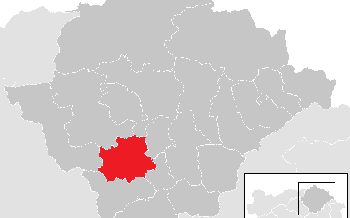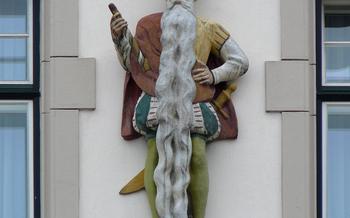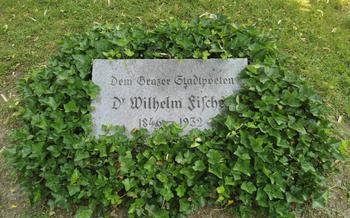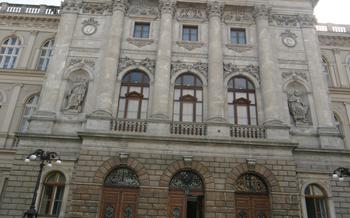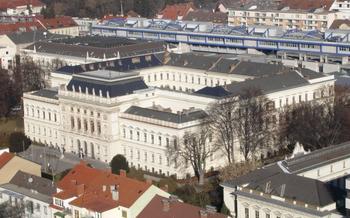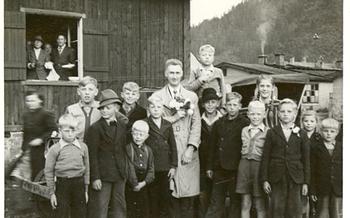
Puch Museum (Vintage Car and Motorcycle Museum)
- The Puch Museum: A Journey Through Automotive History
- The Puch Brand: A Legacy of Innovation
- Vintage Cars: A Glimpse into the Past
- Motorcycles: The Spirit of Adventure
- Interactive Exhibits: Engaging with History
- The Puch Factory: A Legacy of Craftsmanship
- Temporary Exhibitions: A Dynamic Showcase
- The Puch Museum Shop: A Treasure Trove of Souvenirs
- Accessibility and Facilities: Ensuring Inclusivity
- Photography and Social Media: Capturing Memories
- Educational Programs: Inspiring Future Generations
- Research and Preservation: Safeguarding Heritage
- Community Involvement: A Collaborative Spirit
- Insider Tip: Explore the Surroundings
The Puch Museum: A Journey Through Automotive History
In the heart of Graz, Austria, lies a treasure trove of automotive history, the Puch Museum. Established in 1986, this remarkable museum pays homage to the legacy of the Puch brand, a pioneering force in the world of two- and four-wheeled vehicles. Step inside, and you'll be transported back in time, surrounded by a stunning collection of classic cars and motorcycles that have left an indelible mark on the automotive landscape.
The Puch Museum is conveniently located in the Puntigam district of Graz, just a short distance from the city center. Its address is Puchstraße 25, 8020 Graz. For further inquiries, you can reach the museum by phone at +43 316 2720 or send an email to [email protected]
The museum's opening hours are Tuesday to Sunday from 10 am to 5 pm. Admission fees are reasonable, with adults paying €10 and children under 14 entering for free. Guided tours are available upon request and offer a deeper insight into the museum's exhibits and the history of the Puch brand.
The Puch Brand: A Legacy of Innovation
The Puch brand, deeply rooted in Graz, Austria, has left an indelible mark on the automotive industry. Founded in 1885 by Johann Puch, the company initially specialized in bicycle manufacturing. However, it wasn't long before Puch ventured into the realm of motorized vehicles, becoming a pioneer in the field.
Puch's contributions to the automotive world are numerous and significant. The brand played a pivotal role in the development of the modern motorcycle, introducing innovative features that enhanced performance and safety. Puch motorcycles gained a reputation for reliability and durability, becoming popular among both civilian and military riders.
In the realm of car manufacturing, Puch collaborated with renowned automakers such as Fiat and Steyr, producing vehicles that were both practical and stylish. The Puch 500, affectionately known as the "Puch 500," became a symbol of Austrian automotive engineering and remains a sought-after collector's item today.
Over the years, the Puch logo has undergone several transformations, reflecting the brand's evolution and modernization. Initially featuring a simple script logo, Puch gradually adopted a more dynamic and stylized emblem. The current Puch logo, with its bold lettering and vibrant colors, embodies the brand's heritage while projecting a forward-looking image.
The Puch brand's legacy extends beyond its products. It represents a spirit of innovation, craftsmanship, and a commitment to quality that has stood the test of time. The Puch Museum in Graz serves as a testament to the brand's rich history and its enduring impact on the automotive industry.
Vintage Cars: A Glimpse into the Past
The Puch Museum takes visitors on a journey through automotive history, showcasing an impressive collection of vintage cars from different eras. Each vehicle tells a unique story, offering a glimpse into the evolution of design, technology, and cultural trends. Notable models include the 1934 Steyr 50, a sleek and stylish automobile known for its aerodynamic design, and the 1957 Puch 500, a compact and versatile car that was popular for its fuel efficiency and affordability. Visitors can admire the intricate details and craftsmanship of these classic cars, as well as learn about their significance in the automotive landscape. From elegant sedans to sporty convertibles, the vintage car collection at the Puch Museum provides a captivating glimpse into the past, allowing visitors to appreciate the artistry and innovation that have shaped the world of automobiles.
Motorcycles: The Spirit of Adventure
The Puch Museum boasts an extensive collection of motorcycles, each representing a different era and embodying the spirit of adventure. Among the notable models on display is the Puch 500, a legendary motorcycle that gained fame for its reliability and performance during the 1930s. Visitors can also admire the Puch 125 TF, a trailblazing model that set new standards for off-road riding in the 1950s.
The museum's collection showcases the evolution of motorcycle design, with exhibits ranging from early single-cylinder models to modern, high-performance machines. Visitors can explore the technological advancements that have shaped the motorcycle industry, from the introduction of the kick-starter to the development of fuel injection systems.
The Puch Museum's motorcycle collection is a testament to the innovative spirit of the Puch brand. These iconic machines have played a significant role in shaping the history of motorcycling, and they continue to inspire riders around the world.
Interactive Exhibits: Engaging with History
The Puch Museum goes beyond static displays by offering engaging interactive exhibits that bring history to life. Visitors can get hands-on with touchscreens, multimedia presentations, and interactive displays, gaining a deeper understanding of the evolution of Puch vehicles and their impact on society. These immersive experiences allow visitors to engage with the museum's collection, learn about the engineering marvels behind Puch's innovations, and witness the passion and dedication of the people who made these vehicles a reality.
The Puch Factory: A Legacy of Craftsmanship
The Puch factory, established in 1899, played a pivotal role in the development of the Puch brand and the automotive industry in Graz. Initially producing bicycles, the factory expanded its operations to include the manufacturing of motorcycles in 1903 and automobiles in 195
Visitors to the Puch Museum can delve into the rich history of the factory through captivating exhibits and displays. Explore the intricate assembly lines and witness the transformation of raw materials into iconic Puch vehicles. Learn about the skilled craftsmanship and innovative techniques employed by the factory workers, who took pride in their work and contributed to the factory's reputation for excellence.
The evolution of the Puch factory mirrored the growth and success of the Puch brand. Over the decades, the factory underwent expansions and modernizations to meet the increasing demand for Puch products. Its impact on Graz was profound, providing employment and contributing to the city's industrial development. Today, the factory stands as a testament to the enduring legacy of Puch, a symbol of engineering prowess and manufacturing excellence.
Temporary Exhibitions: A Dynamic Showcase
In addition to its permanent collection, the Puch Museum hosts a variety of temporary exhibitions that explore different themes and topics related to automotive history and culture. These exhibitions offer a fresh perspective on the museum's collection and provide visitors with an opportunity to learn about new and exciting aspects of the automotive world.
Temporary exhibitions at the Puch Museum have covered a wide range of topics, from the history of specific car and motorcycle models to the evolution of automotive design and technology. Past exhibitions have showcased iconic vehicles such as the Puch 500, the Puch G, and the Puch Maxi, as well as the latest innovations in electric and autonomous vehicles.
The museum's temporary exhibitions are a great way to learn more about the history and culture of automobiles, and to see some of the most iconic vehicles up close. With new exhibitions opening regularly, there's always something new to see at the Puch Museum.
The Puch Museum Shop: A Treasure Trove of Souvenirs
The Puch Museum Shop is a treasure trove for enthusiasts of all things Puch. Visitors can browse a wide range of Puch-themed merchandise, including scale models of vintage cars and motorcycles, clothing, accessories, and books. These items make for unique gifts and souvenirs, allowing visitors to take a piece of the museum's history home with them.
The shop also offers a selection of rare and exclusive items, such as limited-edition prints, signed memorabilia, and vintage parts. These items are highly sought after by collectors and enthusiasts, making the Puch Museum Shop a must-visit destination for anyone with a passion for Puch.
By making a purchase at the Puch Museum Shop, visitors not only take home a cherished memento but also directly support the museum's ongoing efforts to preserve and showcase the legacy of Puch. The revenue generated from the shop helps to fund the museum's educational programs, conservation projects, and special exhibitions, ensuring that the history of Puch remains accessible to future generations.
Accessibility and Facilities: Ensuring Inclusivity
The Puch Museum is committed to providing an inclusive and accessible environment for all visitors, regardless of their abilities or needs. The museum features wheelchair ramps, elevators, and accessible restrooms, ensuring that everyone can navigate the exhibits and facilities with ease. Additionally, the museum offers assistive listening devices and large-print guides for visitors with hearing or visual impairments.
Families with young children will find the Puch Museum to be a welcoming and engaging destination. Strollers and baby carriers are permitted throughout the museum, and there are designated areas for nursing and diaper changing. The museum also offers a variety of interactive exhibits and activities that are suitable for children of all ages, making it a great place for a fun and educational family outing.
The Puch Museum provides a range of amenities to enhance the visitor experience. Lockers are available for storing personal belongings, and a café offers refreshments and light meals. The museum also has a gift shop where visitors can purchase souvenirs and memorabilia.
The Puch Museum's dedication to accessibility and inclusivity ensures that everyone can enjoy and learn from its exceptional collection of vintage cars and motorcycles. With its thoughtful amenities and welcoming atmosphere, the museum is a must-visit destination for automotive enthusiasts and history buffs alike.
Photography and Social Media: Capturing Memories
The Puch Museum encourages visitors to capture their experiences and share them with the world. Photography is allowed inside the museum, providing an opportunity to document the fascinating exhibits and create lasting memories. Visitors are welcome to take photographs for personal use, but they should be mindful of the privacy of other guests and avoid using flash photography.
Social media platforms offer a powerful tool for visitors to connect with the museum and share their experiences with a broader audience. The museum encourages visitors to use hashtags such as #PuchMuseum, #VintageCars, and #Motorcycles to share their photos and stories. By using these hashtags, visitors can contribute to a vibrant online community of enthusiasts and connect with other like-minded individuals.
The museum's social media presence plays a crucial role in showcasing the collection and engaging with visitors. Through its social media channels, the museum shares captivating images, videos, and stories that bring the exhibits to life and provide insights into the history of Puch. Visitors are encouraged to follow the museum on social media to stay updated on upcoming events, exhibitions, and news related to the Puch brand.
Educational Programs: Inspiring Future Generations
The Puch Museum recognizes the importance of educating future generations about the history and significance of automobiles. To this end, the museum offers a variety of educational programs and workshops tailored to school groups and children of all ages. These programs aim to engage young minds, spark their curiosity, and inspire a passion for automobiles and technology.
Through interactive activities, hands-on demonstrations, and guided tours, children can learn about the evolution of cars and motorcycles, the engineering principles behind their operation, and the impact of automotive innovation on society. The museum's knowledgeable educators use storytelling, multimedia presentations, and interactive exhibits to bring history to life and make learning fun and memorable.
Educational programs at the Puch Museum are designed to align with school curricula and provide teachers with valuable resources to enhance their lessons. Workshops and activities are regularly updated to reflect the latest developments in automotive technology and to address current trends and interests. The museum's goal is to nurture a new generation of automotive enthusiasts who will appreciate, preserve, and contribute to the rich legacy of Puch and the automotive industry.
Research and Preservation: Safeguarding Heritage
The Puch Museum is dedicated to preserving and promoting the legacy of the Puch brand and its contributions to the automotive industry. Ongoing research projects and collaborations with universities, museums, and archives ensure that the museum's collection is well-documented and accurately presented.
The museum's conservation team works tirelessly to maintain and restore the vehicles and artifacts in its collection. They use specialized techniques and materials to ensure that the historical integrity of each item is preserved.
The museum also plays a vital role in raising awareness about the importance of preserving automotive heritage. It organizes conferences, workshops, and lectures to educate the public about the history of the automobile and the significance of the Puch brand.
By safeguarding the legacy of Puch, the museum ensures that future generations can appreciate and learn from the innovations and achievements of this iconic Austrian company.
Community Involvement: A Collaborative Spirit
The Puch Museum is not just a repository of automotive history; it is also an active participant in the cultural fabric of Graz. The museum collaborates with local organizations and institutions to promote automotive culture and heritage. It supports initiatives that celebrate the legacy of Puch and its contributions to the city's identity.
One notable partnership is with the Graz University of Technology. Together, they organize workshops, seminars, and research projects related to automotive engineering and design. These collaborations foster innovation and provide opportunities for students to learn from the museum's vast collection and expertise.
The museum also works closely with the Graz Tourism Board to promote the city as a destination for automotive enthusiasts. They participate in joint marketing campaigns, events, and exhibitions that showcase the unique attractions of the Puch Museum and Graz's rich automotive history.
By engaging with the local community, the Puch Museum not only preserves and celebrates the legacy of Puch but also contributes to the cultural vitality of Graz. It fosters a sense of pride and belonging among residents and visitors alike, creating a vibrant ecosystem where automotive history and contemporary culture intersect.
Insider Tip: Explore the Surroundings
The Puch Museum offers a unique opportunity to delve into the rich automotive history of Austria. However, your journey doesn't have to end here. Graz, the vibrant capital of Styria, beckons you to explore its many other attractions.
Take a leisurely stroll through the historic city center, a UNESCO World Heritage Site, and admire its well-preserved medieval architecture. Visit the Graz Art Museum, showcasing a diverse collection of modern and contemporary art, or immerse yourself in the world of music at the Graz Opera House.
For a taste of local cuisine, head to one of the many traditional restaurants in Graz, where you can sample Styrian specialties such as pumpkin seed oil and roasted pork. And if you're looking for a unique souvenir, be sure to visit one of the many boutiques and shops in the city, where you can find everything from handmade crafts to local delicacies.
To make the most of your visit, consider staying at one of the many charming hotels in Graz. The city offers a range of accommodation options to suit every budget and preference, ensuring a comfortable and memorable stay.
Whether you're a history buff, an art enthusiast, or simply looking for a fun and enriching experience, Graz has something to offer everyone. So, take advantage of your visit to the Puch Museum and explore the many other hidden gems that this beautiful city has to offer.

